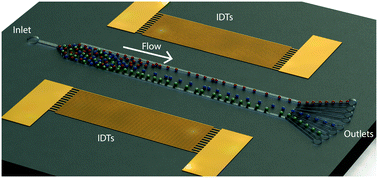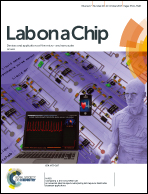Acoustic tweezing of particles using decaying opposing travelling surface acoustic waves (DOTSAW)†
Abstract
Surface acoustic waves offer a versatile and biocompatible method of manipulating the location of suspended particles or cells within microfluidic systems. The most common approach uses the interference of identical frequency, counter propagating travelling waves to generate a standing surface acoustic wave, in which particles migrate a distance less than half the acoustic wavelength to their nearest pressure node. The result is the formation of a periodic pattern of particles. Subsequent displacement of this pattern, the prerequisite for tweezing, can be achieved by translation of the standing wave, and with it the pressure nodes; this requires changing either the frequency of the pair of waves, or their relative phase. Here, in contrast, we examine the use of two counterpropagating traveling waves of different frequency. The non-linearity of the acoustic forces used to manipulate particles, means that a small frequency difference between the two waves creates a substantially different force field, which offers significant advantages. Firstly, this approach creates a much longer range force field, in which migration takes place across multiple wavelengths, and causes particles to be gathered together in a single trapping site. Secondly, the location of this single trapping site can be controlled by the relative amplitude of the two waves, requiring simply an attenuation of one of the electrical drive signals. Using this approach, we show that by controlling the powers of the opposing incoherent waves, 5 μm particles can be migrated laterally across a fluid flow to defined locations with an accuracy of ±10 μm.



 Please wait while we load your content...
Please wait while we load your content...